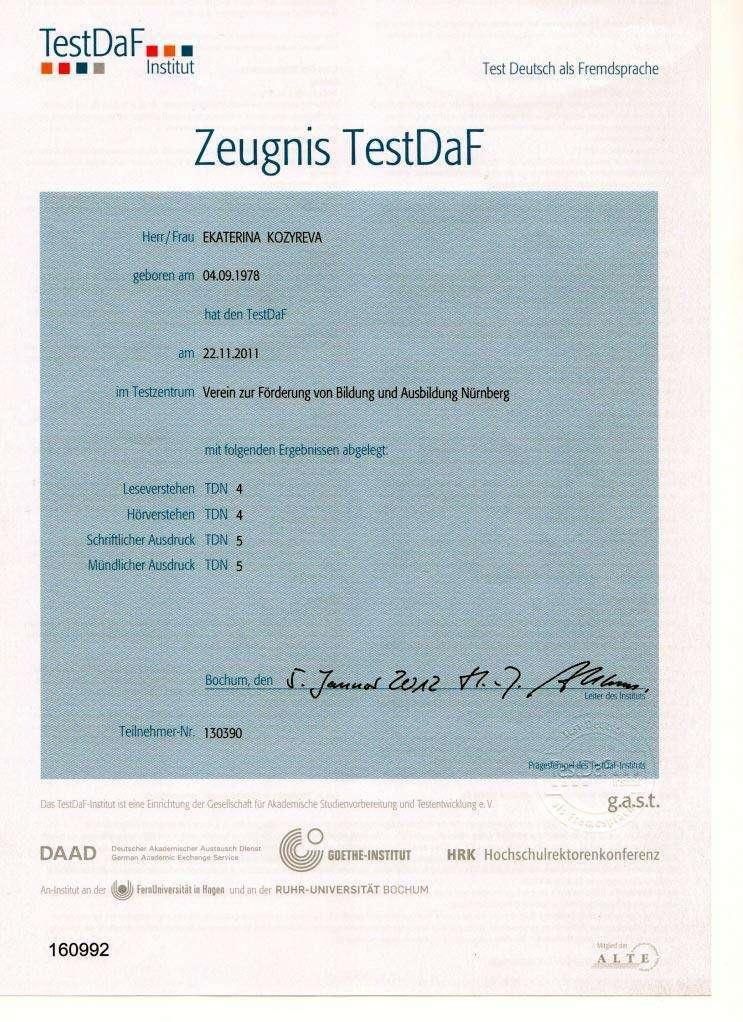Apply to a foreign university with confidence
- Properly fulfilled documents
- Perfect motivation letter
- Support from a personal mentor
- Offers from several universities
Article score: 4.43 out of 5 (7 reviews)
TestDaF is a prerequisite for admission to a university or studienkolleg in Germany.
Free consultation
TestDaF, or Deutsch als Fremdsprache is an international exam used to assess the foreigners’ knowledge of the German language. It is a prerequisite for admission to a university or studienkolleg in Germany. TestDaF results are accepted by most German universities.
| Part | Duration | Paper-based TestDaF tasks | Digital TestDaF tasks | Max.score |
| Leseverstehen — Reading | 60 min. | 30 | 34 | 5 (30) |
| Hörverstehen — Listening | 40 min. | 25 | 30 | 5 (25) |
| Schriftlicher Ausdruck — Writing | 60 min. | 1 | 2 | |
| Mündlicher Ausdruck — Speaking | 35 min. | 7 | 7 | |
| Total | 195 min. | 63 | 73 |
Since 2020, TestDaF has been gradually moving online. Now students can choose the format in which to take the test: digital or paper-based. Universities recognize both. The general structure of the test has not changed, but the number of tasks has increased. For example, in the "Writing" part of the Digital TestDaF, you need to write two essays instead of one. The first is a reasoned answer to a given question, and the second is a comparison of graphs. New tasks have also appeared in the “Reading” section: fill in the blanks, rearrange the paragraphs of a text, find errors, connect related statements[1]. More information about the structure of Digital TestDaF can be found on the website.
The works are evaluated on a three-point scale:
Language proficiency requirements vary from institution to institution. Find out in advance what TestDaF results are needed to enroll in the desired specialty.
Registration for the exam opens 8 weeks prior to testing and lasts 4 weeks. The number of applicants is growing every year, so you need to sign up as early as possible.
Registration for TestDaF is done via the Internet. Simply go to the official website of the exam, choose a suitable date and testing center, fill out an application and pay the fee. When registering, the candidate chooses the exam format: paper or digital. The price is the same: 164 USD for an attempt. The exact cost depends on the country and the certification center. It is more expensive to take TestDaF in Germany — there it costs 198 USD.
The exam results will be available on the official portal one month after testing. Paper certificates are sent from Germany to certification centers in 1.5-2 months. For those who want to get results as soon as possible, it is better to sign up for Digital TestDaF.

Read as much as possible in German, especially magazine articles in the Zeit, Spiegel Online or the Süddeutsche Zeitung. The test will surely contain an academic text on science, technical development or economics, so it is important to be familiar with such publications. Listen to German speech to improve your speaking skills. You can take preparatory courses, go to a conversation club, or watch movies and listen to the radio in German. This will help you build vocabulary and learn more common expressions. Another effective method is communicating with a native German speaker. If it is not financially possible, it is enough to register on a website for language learners, for example Tandempartners.
Don't skimp on study materials. The tasks in the test are anything but basic, and even a native speaker will experience difficulties if they do not familiarize themselves with the format in advance. Only daily practice will help you achieve high results. A list of the best study guides can be found on the official exam website as well as on the Goethe Institute website.
The amount of time allotted for the test (3 hours 10 minutes) is often not enough to complete, check and enumerate all tasks. To successfully pass TestDaF, learn how to manage your time correctly. You should not stall for too long on one hard question: it is better to skip a difficult task and move on to the next. Otherwise, you may never get to the last tasks of the section.
The writing part is perhaps the most difficult. Describing statistical graphs in an essay is a very specific task. The statistics can come from any field — for example, comparative population growth rates of England and Germany. In order to have the time to cover all the necessary points in the essay, sketch out a short outline and break the text into parts (introduction, main part and conclusion). To deal easily with describing graphs and tables, familiarize yourself with the relevant vocabulary (various parameters, percentages, comparisons and descriptions, growth, increase, decrease, etc). The writing section assesses the candidate's ability to write coherent text using introductory words and set expressions. A list of popular speech constructs can be found here.
Speaking is usually the most stressful part of the exam. Very little time is given to think about the answer. It will not be possible to write down all your thoughts, so it is better to sketch out a small plan of the answer and highlight the keywords that you can use as reference while speaking. Use sample tests to study the speaking tasks in advance and prepare answers to them.
Be sure to take a few practice tests before the exam. You can find them on the Internet or in tutorials. Try to make your practice as close as possible to the real exam: comply with the time limits and gradually solve the tasks section by section.
60+ countries
we work with
$1,000,000 saved
by students through scholarships
6,400 offers
our students got